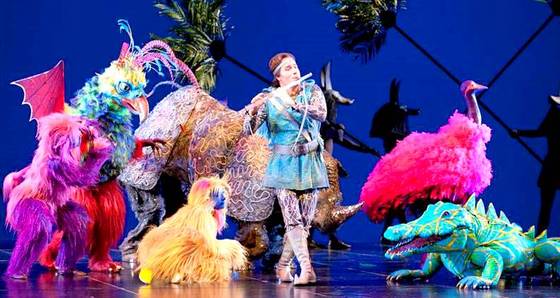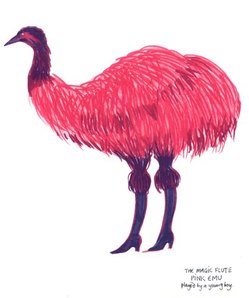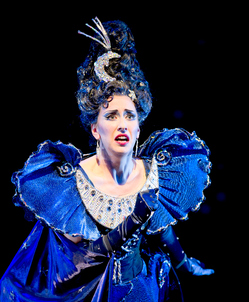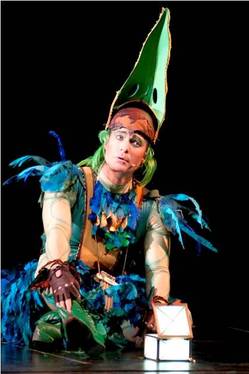
Tamino (John Tessier) entertains a menagerie with his magic flute. Seattle Opera photos © Rozarii Lynch
Mozart's final opera, "The Magic Flute," is both a fairy tale (supposedly for children) and a morality play (supposedly for grownups). In the current production at Seattle Opera, the better part by far is the fairy tale.
"The Magic Flute" is often described as an ideal "first opera" for newbies because some of its characters are goofy and childlike. But kids today, growing up with Big Bird, Elmo and Kermit, may not be impressed by a man in a bird suit playing a tune on the glockenspiel. It's the grownups who are, because the costumes are dazzling.
The British fashion designer Zandra Rhodes created them for a 2001 production by San Diego Opera, and updated them for the current Seattle version. The hero and heroine come off with the least interesting outfits (your basic light blue tunics), while the villains get deep purple tops and striped pantaloons. The stately good guys (and ladies) wear golden vestments that look like Flash Gordon firefighter slickers. Rhodes's cloak for the Queen of the Night is all dazzling blue and black and silver, while the three guiding spirits, in metallic, mid-thigh spandex, look like they're about to head onto the football field for Friday Night Lights. The most endearing are her costumes for Papageno and Papagena, who get to wear bird suits with beaks and tail feathers.
 And then there are the captivating animals: a fearsome Chinese dragon that wheezes its last within the first minute (it causes the hero to faint dead away before it's dispatched by the Ladies of the Night). A little later, though, a whole menagerie of beasts appears: a day-glo pink emu among an assortment of fantasmagorical birds, along with a crocodile, a rhino, and tumbling monkeys.
And then there are the captivating animals: a fearsome Chinese dragon that wheezes its last within the first minute (it causes the hero to faint dead away before it's dispatched by the Ladies of the Night). A little later, though, a whole menagerie of beasts appears: a day-glo pink emu among an assortment of fantasmagorical birds, along with a crocodile, a rhino, and tumbling monkeys. The cuddly beasts make their appearance as Tamino blows a couple of test-toots on the magic flute he's been given by the maniulative Queen. Her role is sung, in the Gold cast, with great verve and clarity by coloratura soprano Emily Hindrichs, who has the vocal skills, if not the physical stature, of a menacing madwoman. On the other hand, the Russian bass (and former professional basketball player) Ilya Bannik towers over the cast as Sarastro, but doesn't have quite the resonance to be convincing as the voice of wisdom. It falls to baritone Philip Cutlip (Enrico in last year's "Lucia di Lammermoor") to provide the best singing of the night as the bird-catcher Papageno. It's the part the librettist, Emanuel Schikaneder, wrote for himself, and it's got the easiest music and the best bits of schtick as well.
The cuddly beasts make their appearance as Tamino blows a couple of test-toots on the magic flute he's been given by the maniulative Queen. Her role is sung, in the Gold cast, with great verve and clarity by coloratura soprano Emily Hindrichs, who has the vocal skills, if not the physical stature, of a menacing madwoman. On the other hand, the Russian bass (and former professional basketball player) Ilya Bannik towers over the cast as Sarastro, but doesn't have quite the resonance to be convincing as the voice of wisdom. It falls to baritone Philip Cutlip (Enrico in last year's "Lucia di Lammermoor") to provide the best singing of the night as the bird-catcher Papageno. It's the part the librettist, Emanuel Schikaneder, wrote for himself, and it's got the easiest music and the best bits of schtick as well. From the pit, Gary Thor Wedow kept track of singers, players and technical effects ("Das Glockenspiel ist kaput!") with great musical aplomb, and for this production he inserted a few lines from a newly discovered libretto. But I was disappointed that one line, in particular, was excised. There's an exchange between Papageno and the wicked jailer, Monastatos, in Act One, when they first see one other, and each assumes the other is the devil incarnate. Papageno hasn't ever seen a black person, but soon reconsiders:
From the pit, Gary Thor Wedow kept track of singers, players and technical effects ("Das Glockenspiel ist kaput!") with great musical aplomb, and for this production he inserted a few lines from a newly discovered libretto. But I was disappointed that one line, in particular, was excised. There's an exchange between Papageno and the wicked jailer, Monastatos, in Act One, when they first see one other, and each assumes the other is the devil incarnate. Papageno hasn't ever seen a black person, but soon reconsiders:Es gibt ja schwarze Vögel in der Welt, warum denn nicht auch schwarze Menschen?
"There are black birds in the world, why shouldn't there be black people as well?"
It's a defining moment for the dim-witted birdcatcher, an important step in his own spiritual development. After all, why should Tamino and Sarastro get all the benefit from the Temple of Wisdom's (read "Masonic") humanism? ("In these hallowed halls, one forgives one's enemies.") Papageno, the opera's Everyman, deserves enlightenment as much as the vapid Tamino.
And vapid he is. Despite John Tessier's best vocal efforts, he's the weakest character onstage, out-acted by the baritone, outclassed by the bass, outsung by both Pamina and the vengeful Queen, and upstaged by the animals.